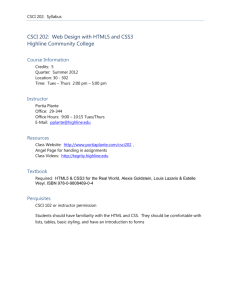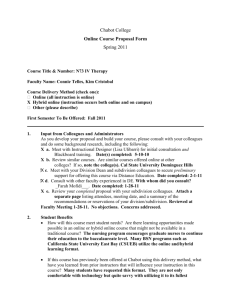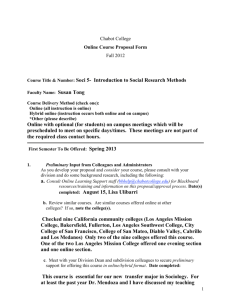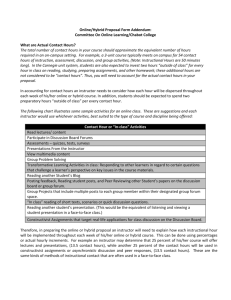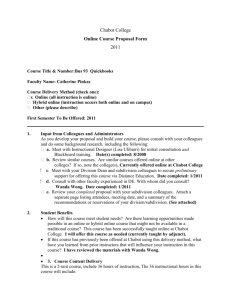CSCI 15 - Chabot College
advertisement
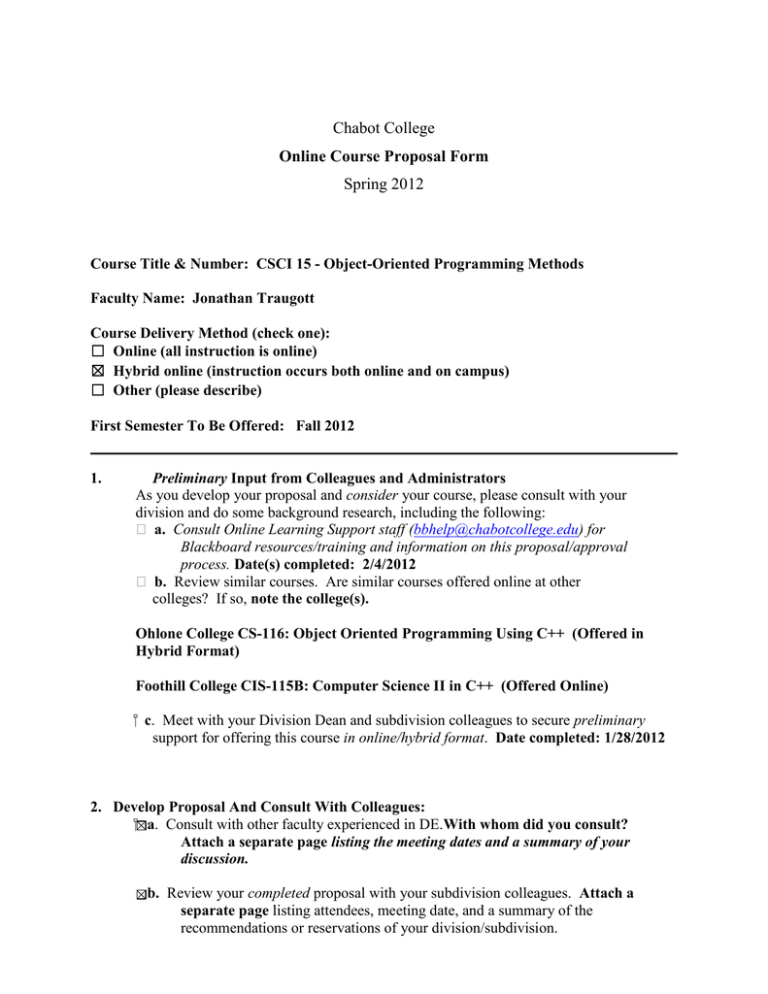
Chabot College Online Course Proposal Form Spring 2012 Course Title & Number: CSCI 15 - Object-Oriented Programming Methods Faculty Name: Jonathan Traugott Course Delivery Method (check one): ☐ Online (all instruction is online) ☒ Hybrid online (instruction occurs both online and on campus) ☐ Other (please describe) First Semester To Be Offered: Fall 2012 1. Preliminary Input from Colleagues and Administrators As you develop your proposal and consider your course, please consult with your division and do some background research, including the following: a. Consult Online Learning Support staff (bbhelp@chabotcollege.edu) for Blackboard resources/training and information on this proposal/approval process. Date(s) completed: 2/4/2012 b. Review similar courses. Are similar courses offered online at other colleges? If so, note the college(s). Ohlone College CS-116: Object Oriented Programming Using C++ (Offered in Hybrid Format) Foothill College CIS-115B: Computer Science II in C++ (Offered Online) c. Meet with your Division Dean and subdivision colleagues to secure preliminary support for offering this course in online/hybrid format. Date completed: 1/28/2012 2. Develop Proposal And Consult With Colleagues: a. Consult with other faculty experienced in DE.With whom did you consult? Attach a separate page listing the meeting dates and a summary of your discussion. b. Review your completed proposal with your subdivision colleagues. Attach a separate page listing attendees, meeting date, and a summary of the recommendations or reservations of your division/subdivision. 3. Student Benefits How will this course meet student needs? Are there learning opportunities made possible in an online or hybrid online course that might not be available in a traditional course? We will be offering CSCI 15 in hybrid format with 50% of the course taught online and 50% taught in the classroom. This format provides weekly contact with the instructor while still accommodating students who have trouble coming to campus twice a week. The use of MyProgrammingLab will allow the instructor to view student code as it is compiled or run and provide help in close to real time. This would not be practical in a traditional course since students typically do more of their work at home, outside of the physical lab. 4. If this course has previously been offered at Chabot using this delivery method, what have you learned from prior instructors that will influence your instruction in this course? This course has not been previously offered in hybrid or online format. But a similar course (CSCI 14) has been very successful in hybrid format Course Content Delivery The total number of contact hours in your course should approximate the equivalent number of hours required in an on-campus setting. For example, a 3-unit course typically meets on campus for 54 contact hours of instruction, assessment, discussion, and group activities. In the Carnegie unit system, students are also expected to invest two hours “outside of class” for every hour in class on reading, studying, preparing assignments, and other homework; these additional hours are not considered to be “contact hours”. Account for the contact hours in your proposal in a clear, detailed and specific way. (PLEASE NOTE: For a more detailed explanation of “contact hours”, be sure to see the Addendum attached to this form.) CSCI 15 meets 108 hours per semester. In hybrid format 54 of those hours will be taught online, allocated as follows: Lab Assignments (MyProgrammingLab) – 27 E-lectures (Camtasia screencasts, PowerPoint presentations) – 12 Quizzes– 5 Discussion Board / Email communications – 10 What percentage of the course will be on-campus, if any? What percentage of the course will consist of online lecture (text, presentations, podcasts, video), class discussions (discussion board forums), group projects (blogs, journals), online resources (Publisher content/websites, coursecartridges/packages), assignments, student research, reading, writing, & assessments?Please be sure to list each of your contact hour/instructional activities and indicate how these will be delivered throughout the course and the amount of hours or percentage that they will entail. CSCI 15 has three hours of lecture and three hours of lab per week. In hybrid format the lecture and lab will both be delivered 50% online. Therefore fifty percent of the lab will be done at home (on the student's computer using MyProgrammingLab software) and fifty percent will be done on campus in a physical computer lab. Similarly, fifty percent of the lecture will be online via electures, videos, PowerPoint presentations, discussions and assessments. The other fifty percent of lecture will fifty will be on campus in a physical classroom. Will any portion of your course be synchronous, requiring students to be online at the same time? If so, describe those activities, and how you will provide flexibility for students who may be unable to participate at any given time. No synchronous online activity is planned for CSCI 15. Collaborative assignments will take place during the on campus meetings, in lecture or lab. 5. Nature and Frequency of Instructor-Student Interactions How and how frequently will you interact with your students? This should include interactions with the entire class, providing feedback on assignments, and interventions when students are at-risk of dropping or failing due to poor performance or participation. Students are required to maintain regular email correspondence with the instructor and to come to office hours a minimum of 4 times per semester. The instructor will monitor participation in the discussion board to ensure that students are actively engaged in the class. Students who fail to participate will be contacted individually. The Announcements section of Blackboard will be used to post announcements, deadlines and hints for the assignments. The instructor will hold traditional office hours on campus and will contact students via email and/or phone. MyProgrammingLab will enable the instructor to closely monitor students while they program and intervene quickly when students are obviously stuck or have hit a roadblock. 6. For each type of interaction, describe why you believe it will be effective for this particular course. Nature and Frequency of Student-Student Interactions Describe opportunities in your course for student to student interaction. This may include discussions, group projects, peer review of assignments, and other approaches. Consider how students interact in this course when taught on campus; how can you build this type of learning community online? Students will work together for in-class assignments during lecture ("Collaboratives") as well as in the Campus lab on programming assignments. For online, discussions will also be carried out in the “Discussion Board”. For example, students may be assigned to participate in a whole class discussion where they can post a question or post a response to a question. Unlike other subjects, programming does not only encounter right vs. wrong solution, but also the right solution vs. the better and more efficient solution. Through Discussion Board students will be able to discuss different approaches in their programming assignments and concepts. 7. Assessment of Student Learning How will you assess learning in this course? Given the nature of online courses, how does your assessment plan ensure a level of academic integrity with which you’re comfortable? Describe how your assessment plan is consistent with your stated goals in the student benefits and student-student interactions sections of your proposal. How will you provide feedback to students? Weekly quizzes to help students assess their understanding of the material Tests will be on campus and/or online through MyProgrammingLab Quizzes and tests feedback will be provided during campus lectures 8. Technology Describe any software or multimedia tools you plan to utilize in your course: PowerPoint (with or without audio),Publisher content/websites, Course Cartridges/Packages, Camtasia, Jing, Dragon Naturally Speaking, Flash, Audio (including Audacity and podcasts),YouTube/EduStream/Web-based videos, etc.). This is helpful to determine technology support needs. Please be specific in listing the technological tools you intend to use for your online or hybrid course. CSCI 15 will use MyProgramming Lab (Pearson) to provide an environment in which students complete their programming assignments online. MyProgrammingLab allows students to have their programs tested and corrected automatically as they enter code. It also provides online communication with the instructor centered around individual problems. Thus the instructor may view student code as it is entered and provide guidance in a timely manner. CSCI 15 will use Camtasia to produce online lectures and screencasts which students may view online. CSCI 15 will use TestGen for Starting Out with C++: From Control Structures through Objects, 7/E to deliver some assessments online. CSCI 15 will use Blackboard as the main portal for delivering assignments, announcements, course materials, online assessments, sample code, discussions, and online help. CSCI 15 will use compiled C++ programs that the student may download and run directly on their home computer. The compiled programs will be solutions to programming assignments and sample programs to supplement the lecture. Thus the student will be able to see not just the source code but the intended behavior of various C++ programs. 9. Accommodations for Students with Disabilities Is any required video close-captioned? Is there any required audio accompanied by a transcript? If you plan to use any multimedia (video, audio, publisher sites specialized software), is that accessible to your students in terms of both software availability at home and on campus and accessible for students with disabilities? Have you provided alt-tags for your key images used in your course? Please contact the Chabot DSRC (Disabled Students Resource Centerhttp://www.chabotcollege.edu/DSRC/) if you need help in ensuring accessibility for your students. Blackboard has accessibility feature to accommodate students with disabilities. Students that require assistance with disabilities can also use services in DSRC as available by Chabot. 10. Submit your proposal (electronic version via email and hard copy via campus mail) to the chair of the Committee on Online Learning. Faculty signature: _______________________________ Date: _______________ Division Dean signature: __________________________ Date: ________________ Online/Hybrid Proposal Form Addendum: Committee On Online Learning/Chabot College What are Actual Contact Hours? The total number of contact hours in your course should approximate the equivalent number of hours required in an on-campus setting. For example, a 3-unit course typically meets on campus for 54 contact hours of instruction, assessment, discussion, and group activities, (Note: Instructional Hours are 50 minutes long). In the Carnegie unit system, students are also expected to invest two hours “outside of class” for every hour in class on reading, studying, preparing assignments, and other homework; these additional hours are not considered to be “contact hours”. Thus, you will need to account for the actual contact hours in your proposal. In accounting for contact hours an instructor needs to consider how each hour will be dispersed throughout each week of his/her online or hybrid course. In addition, students should be expected to spend two preparatory hours “outside of class” per every contact hour. The following chart illustrates some sample activities for an online class. These are suggestions and each instructor would use whichever activities, best suited to the type of course and discipline being offered: Contact Hour or “In-class” Activities Read lectures/ content Participate in Discussion Board Forums Assessments – quizzes, tests, surveys Presentations From the Instructor View multimedia content Group Problem Solving Transformative Learning Activities in class: Responding to other learners in regard to certain questions that challenge a learner’s perspective on key issues in the course materials. Reading another Student’s Blog Posting feedback, Reading student posts, and Peer Reviewing other Student’s papers on the discussion board or group forum. Group Projects that include multiple posts to each group member within their designated group forum space. “In class” reading of short texts, scenarios or quick discussion questions. Reading another student’s presentation. (This would be the equivalent of listening and viewing a student presentation in a face-to-face class.) Constructivist Assignments that target real-life applications for class discussion on the Discussion Board. Therefore, in preparing the online or hybrid proposal an instructor will need to explain how each instructional hour will be implemented throughout each week of his/her online or hybrid course. This can be done using percentages or actual hourly increments. For example an instructor may determine that 25 percent of his/her course will offer lectures and presentations, (13.5 contact hours), while another 25 percent of the contact hours will be used in constructivist assignments or asynchronistic discussion and peer responses, (13.5 contact hours). These are the same kinds of methods of instructional contact that are often used in a face-to-face class. However, there are certain learning activities that may not meet the criteria of actual “contact hours”. This chart reflects instructional, preparatory “outside of class” activities that in some cases would not necessarily be considered actual contact hours. Preparatory or “Outside of Class” Activities Read Textbooks Research Preparing assignments Viewing an internet site for one’s own research purposes. Individual Reflective Writing Journaling Writing /Composing a Blog Analyzing another student’s ideas individually. Using a WIKI for posting ideas to other class members in preparation for a Group Project. Outside reading of additional texts pertaining to the course subject matter as homework preparation. Preparing an individual class presentation. Reviewing class notes. In summary, “contact hours” are usually those segments of instructional time where the student is actively engaged in learning activities and would reflect the same type of instruction implemented in a traditional face-to-face classroom. Therefore, instructors are encouraged to offer a clear breakdown of “contact hours” in the section of the proposal entitled, “Course Content Delivery”. Summary of 2/3/2012 Meeting with Desmond Chun and Keith Mehl and Jon Traugott re. Offering CSCI 15 in Hybrid Format CSCI 15 (Introduction to Object Oriented Programming) is proposed to be offered in hybrid format for Fall 2012. There were no objections to using the hybrid format for this course. We’ve already had success with the hybrid format in CSCI 19A (Introduction to Object Oriented Programming in Java) and expect the outcomes will be similar with CSCI 15. Since we’ve already incorporated MyProgrammingLab into the curriculum for CSCI 19A, adapting this tool for CSCI 15 should be relatively straight forward. It was noted that the textbook for CSCI 15 is the same as the prerequisite course CSCI 14 (Starting Out with C++: From Control Structures through Objects, 7/E) so students having taken the prerequisite can keep their textbook and buy access to MyProgrammingLab online. New students can buy the textbook packaged with MyProgrammingLab at the Chabot College bookstore.

